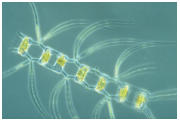|
Nature Geoscience published this very interesting editorial on the recent political controversy surrounding LOHAFEX.
The full text of the editorial is below:
The Law of the Sea
Abstract
In 2008
ocean iron fertilization was regulated under two sets of international
legislation. However, unclear definitions have led to the suspension of
legitimate research.
Introduction

RICHARD CRAWFORD, ALFRED-WEGENER-INSTITUT
Base of the food chain: Antarctic phytoplankton. When
a marine research project is put on hold by the lead country's science
ministry, after the research vessel has already set sail, it is clear
that communication between scientists, the public and politicians has
gone seriously wrong. The suspension of the Indo–German iron
fertilization experiment LOHAFEX in January this year is a case in
point.
LOHAFEX (taken from loha, the Hindi word for
iron, and FEX, which stands for fertilization experiment) aims to study
the biogeochemical effects of iron fertilization in the South Atlantic
Ocean. Just when the research vessel was about to leave the port,
environmental groups protested against the experiment, arguing that the
experiment breached a May 2008 decision agreed on by the parties of the
United Nations convention on biodiversity. The decision restricts iron
fertilization to small-scale, scientific research studies within
coastal waters. The protests resulted in a two-week suspension of the
experiment, and left 48 scientists onboard the research vessel Polarstern wondering if they were sailing across the South Atlantic in vain.
By
early February, the research was back on track. The scientists had made
good use of the delay — identifying a suitable target eddy in the
region. The team required a stable eddy that contained plenty of
nutrients, but was low in productivity. This would allow the iron
addition to have a significant effect and provide a fairly closed
experimental system. So, when approval of the experiment came through
the iron was injected promptly, and has since stimulated the expected
plankton bloom. The fate of carbon in this system is now being
monitored as planned.
However, the controversy
leaves the scientists bruised, the environmental groups wondering
whether the UN's moratorium on iron fertilization will prevent
premature geoengineering, and the German Federal Environment Ministry —
whose support of the environmental protesters was instrumental in
achieving the experiment's suspension — unsatisfied.
The
rationale of the UN moratorium on ocean iron fertilization was to stop
the commercial companies who were getting ready to make money by adding
large amounts of iron to suitable regions of the ocean and selling
carbon credits in return (Science 318,
1368–1370; 2007). The UN convention on biodiversity decided that the
world is not yet ready for widespread fertilization efforts, certainly
not on an industrial-type scale: neither the capacity for carbon
capture nor the potential adverse effects are sufficiently understood
(see Nature Geosci. 1, 722–724; 2008) — an assessment most scientists would agree with.
The
January controversy has raged over the definitions of the terms of
exemption for scientific studies — 'small-scale' and 'coastal waters' —
which were not clarified in the text of the decision. Whether
fertilization of an ocean eddy with a surface area of around 300 km2,
as planned in the LOHAFEX experiment, can be classified as small-scale
is not straightforward, and a location hundreds of kilometres from the
nearest land mass is not obviously within coastal waters.
These
definitions must be seen in context. If the Southern Ocean were a
garden, the fertilized eddy would be the size of a daisy, as pointed
out by Karin Lochte — director of the Alfred-Wegener Institute for
Polar Research under whose flag the Polarstern is sailing — in an online newspaper report (http://www.spiegel.de/wissenschaft/natur/0,1518,602984,00.html).
The project scientists argue that the water in their study region is
considerably influenced from land, by atmospheric deposits as well as
some constituents from the water, and can therefore be considered
coastal.
Whatever the answer, the row over
definitions is missing the point. At least the restriction to coastal
waters in the UN moratorium seems arbitrary. The London Convention and
Protocol, a legal body within the framework of the international Law of
the Sea, which regulates dumping and marine pollution, does not refer
to the terms 'small-scale' and 'coastal waters' in its October 2008
resolution on ocean fertilization. Instead, it distinguishes between
"legitimate scientific research", which is permitted, and "other
activities". As a result of both the chronology and the fact that the
international Law of the Sea takes legal priority over the UN
convention on biodiversity, this emphasis on legitimate science seems
more relevant.
The term 'legitimate', too, will need
further definition. Indeed, a working group of the London Convention
met in February with the aim of drafting more detailed regulations that
will make it easier to assess whether expeditions are scientifically
legitimate. However, there is little doubt that LOHAFEX passes this
criterion.
Given this situation, the question arises
as to why the research was held up in the first place. A press release
issued by the German Federal Environmental Ministry to express its
regret when the experiment was approved gives a clue. It states that in
its own view "attempting to halt climate change by interfering with our
marine ecosystems is a disastrous approach. This scientifically unsound
thinking has been a direct cause of the climate crisis and is in no way
suited to solving the problem." If this is the reason for condemning
LOHAFEX, then the statement seems to imply that ocean fertilization
(and, by extrapolation, other options of geoengineering) must not be
investigated at all.
But closing our eyes will not
make global warming go away. In case climate change continues we should
at least rule out scientifically, as early as we can, geoengineering
proposals that do not work — so that future generations do not go down
disastrous routes because there is no more time for detailed studies.
|

